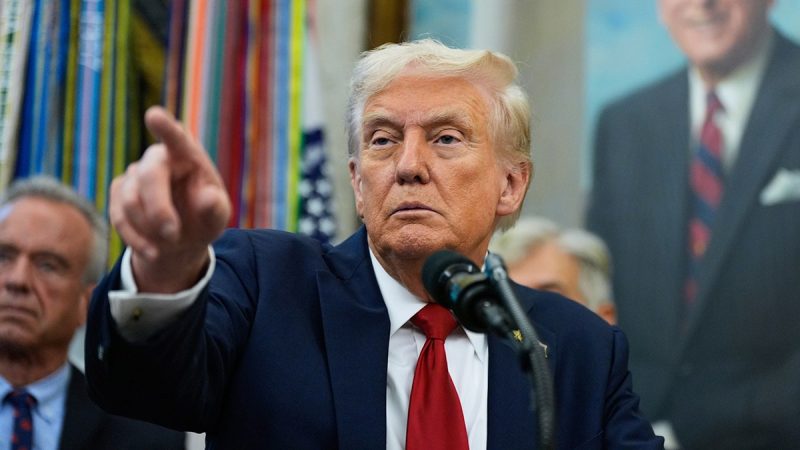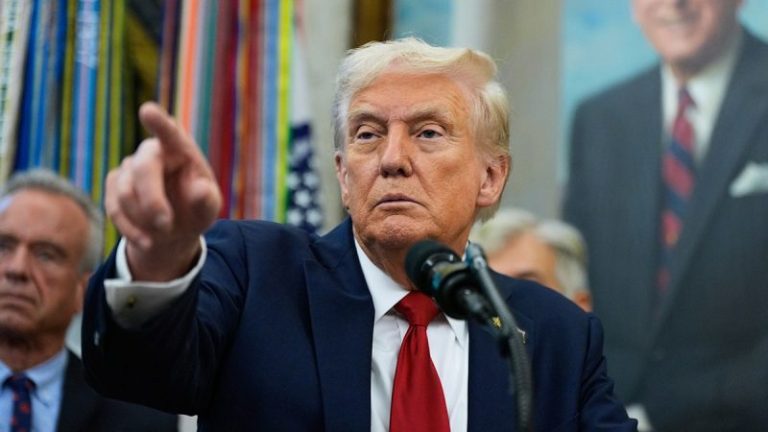
Office of Management and Budget (OMB) chief Russell Vought and President Donald Trump are in the midst of mapping out cuts to the federal government after lawmakers on Capitol Hill failed to reach a funding bill agreement early Wednesday morning.
Trump set the stage in the lead-up to the shutdown that the federal government is set to likely see staffing and program cuts under the shutdown, adding in a Thursday message to Truth Social that many federal agencies are a ‘political SCAM.’
‘I have a meeting today with Russ Vought, he of PROJECT 2025 Fame, to determine which of the many Democrat Agencies, most of which are a political SCAM, he recommends to be cut, and whether or not those cuts will be temporary or permanent,’ Trump posted.
‘I can’t believe the Radical Left Democrats gave me this unprecedented opportunity. They are not stupid people, so maybe this is their way of wanting to, quietly and quickly, MAKE AMERICA GREAT AGAIN!’ he added.
Fox News Digital spoke with Heritage Foundation’s director of the Grover M. Hermann Center for the Federal Budget, Richard Stern, Thursday morning to discuss which agencies the OMB chief would likely target for staffing cuts and if such cuts would be permanent.
How a shutdown enables cuts
Stern explained to Fox Digital that there are a pair of overlapping issues that lead to the government’s staffing size: agencies are required by various laws to provide certain services to citizens. And, separately, appropriation bills set funding floors on how much money an agency has available to spend on staff payroll.
During a shutdown, however, there is a lapse in funding, meaning agencies do not have ‘payroll floors from the funding bill,’ leaving the executive branch with discretion on how to continue providing required services to citizens, he explained.
‘Because the funding bills set effective floors per salary spending, that tends to dictate how many people work for the agencies. In the event of a shutdown, the only requirement on the administration is to ensure that the agencies provide the services and whatnot that are required by law. But those laws don’t say you need, you know, 100 staffers to write a grant or only one staffer,’ Stern told Fox Digital in a phone interview.
‘They simply say, you know, ‘There’s a grant program that has to go out the door under XYZ parameters.’ So in the event of a lapse in funding, it means that the administration … can lay out a plan saying, ‘Hey, look, you know, we think the Department of Education, for example, could do everything it is legally required to do, but do it with 10% of the workforce,’’ he continued.
If the administration determines that an agency can fulfill its legally required services to citizens with fewer people, it will subsequently send reduction in force notices, known as RIFs, to staffers.
‘If the funding was there, and if the funding law required those staff levels, then you wouldn’t be able to RIF,’ he said. ‘But in the lapse of funding, it gives the White House that opportunity.’
Permanent changes to the government are in a gray zone, however, as RIFs would not be able to take effect until after 60 days.
‘Once the RIF notices go out, you … legally need to wait 60 days before the RIF notices can be enacted,’ Stern continued. ‘Really the shutdown would have to last 60 days, beyond that, to actually act on the RIFs.’
The Heritage Foundation expert, who also serves as the conservative think tank’s acting director of the Thomas A. Roe Institute for Economic Policy Studies, stressed that any staffing cuts are not an example of government ‘downsizing.’
‘It’s not downsizing the activities of agencies,’ he said. ‘It’s not reducing what they make available, what services they provide. It’s simply reducing the workforce that’s providing the same level and the same amount of services.’
What agencies could be targeted for cuts?
White House press secretary Karoline Leavitt told a gaggle of reporters Thursday that ‘thousands’ of federal employees could be laid off during the shutdown.
‘Look, it’s likely going to be in the thousands. It’s a very good question. And that’s something that the Office of Management and Budget and the entire team at the White House here, again, is unfortunately having to work on today,’ Leavitt said.
Stern pointed to a handful of agencies that will likely be targeted for layoffs, citing agencies that have ‘mission creeped’ their original purview into regulatory issues, such as the Environmental Protection Agency, as well as other agencies, like the National Science Foundation, that handle grant writing for programs.
‘Probably the Department of Ed is, is kind of the poster child on this one,’ he said. ‘They’ve been talking about, they quite literally only need 10% or so on the staff.’
He also noted the EPA, Department of the Interior and the Department of Labor could face cuts due to the various agencies’ ‘mission creep into a lot of regulations that are quite harmful to the economy, that are quite harmful to just American families.’
‘EPA over … a decade or so, has mission creeped its jurisdiction into more and more regulatory affairs, that just simply, the EPA doesn’t have under a statutory capacity,’ he said. ‘They’re regulating outside of the confines, the charge they were given by law, by Congress. So EPA is another one of those where that makes a lot of sense to cut a lot of the workforce there. Then, at HUD and Department of Labor you have similar things.’
Stern said the administration likely is also eyeing agencies such as the National Science Foundation, National Endowment for the Arts and Humanities, and certain aspects of the Department of Housing and Urban Development that are charged with ‘running programs that write grants where there’s an enormous amount of legal discretion on who gets the grant money.’
‘These grants are not serving some critical, or frankly, constitutional role,’ he said, adding the grants often land in the hands of universities and promote ‘left-wing’ ideology on topics, such as transgenderism and climate change.
What has Trump said on federal cuts?
Trump said during various public remarks Tuesday, as the deadline clock began to run dry, the shutdown presented him with the opportunity for the administration to carry out layoffs as part of a continued mission to slim down the federal government, and snuff out overspending and fraud. Trump, however, repeatedly has stressed he does not support the shutdown, pinning blame on Democrats.
‘We don’t want it to shut down because we have the greatest period of time ever,’ Trump said from the Oval Office Tuesday. ‘I tell you, we have $17 trillion being invested. So the last person that wants it shut down is us.’
‘Now, with that being said, we can do things during the shutdown that are irreversible, that are bad for them and irreversible by them, like cutting vast numbers of people out, cutting things that they like, cutting programs that they like,’ he continued.
Republicans have pinned the shutdown blame on Democrats, arguing they refused to fund the budget as an attempt to reinstate taxpayer-funded medical benefits for illegal immigrants. Democrats have countered that claim as a ‘lie’ and cast blame for the shutdown on Republicans.
‘A lot of good can come down from shutdowns,’ Trump added Tuesday. ‘We can get rid of a lot of things that we didn’t want, and they’d be Democrat things. But they want open borders. They want men playing in women’s sports. They want transgender for everybody. They never stop. They don’t learn. We won an election in a landslide.’
Trump’s second administration has spotlighted the size of the federal government as bloated since inauguration day, including the president launching the Department of Government Efficiency to weed out potential fraud, overspending and corruption, and offering federal employees voluntary buyouts in January to leave their posts before rolling out other RIF initiatives across various agencies.
Fox News Digital reached out to OMB’s office for comment on the anticipated cuts but did not immediately receive a reply.
Fox News Digital’s Elizabeth Elkind and Anders Hagstrom contributed to this report.



